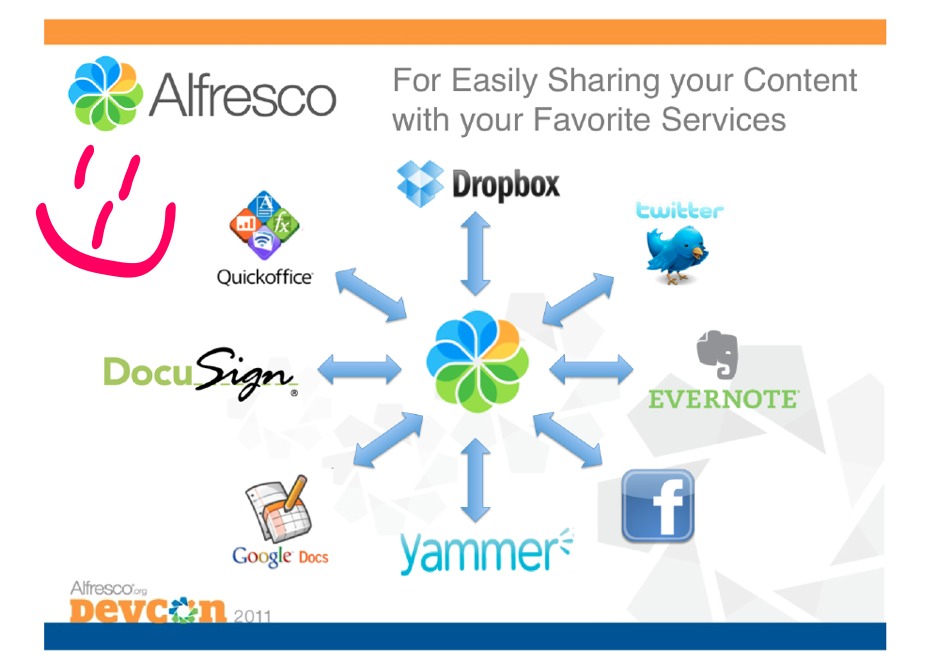I began researching what we now call Cloud Content Management and Social Business in the fall of 2008. I had spent nearly a decade working with a very dedicated group of professionals to build a nationally recognized systems integration company in the Northwest. Over the years the company worked with many familiar content management products including Optika, Kofax, OTG, Cardiff, Stellent, OnBase, OIT and many others. Like many regional VAR’s and Systems Integrators we worked in familiar verticals like government, transportation, financial services and healthcare to build out accounts payable, claims processing, human resources, electronic health records and many other document centric and workflow oriented business processes.
Like many ECM veterans I watched the industry shift from 2005 – 2008 as massive consolidation of the marketplace occurred. The founder of Alfresco, John Newton posted on his blog in 2006 that “Clearly, the reason for these mergers is not for technology, but for market share and customer base.” A prime example of this is the cascading acquisitions of Optika to Stellent and then to Oracle. After the acquisition the partner channel was all but disbanded as Oracle went on to take many of the larger customers direct by offering sweet software maintenance renewals at opportune times. Any acquiring company gets that right, especially when you pay $440M to get a foothold in a high growth market like content management. This is just one example of how the market shifted creating an environment that required partners, customers and competition to adapt. I don’t believe that much adaptation actually occurred in fact many of those Legacy platforms and VAR’s still exist today largely unchanged. In the case of Oracle they actual used only portions of the software technology that they acquired and focused instead on building a newer Java based platform from scratch, incorporating other technologies like AquaLogic to create a more integrated platform that supports the proliferation of their ERP and Database assets. Instead if adaptation a whole new era of content creation and management occurred.
It was November 2009 when I first understood that the industry was bound for yet another chapter in this saga. With social media, posts, tweeting and friending all the rage it was clear that a new age of content creation and ultimately the need to manage that content in a structured way would be required. FaceBook, SalesForce, eBay, Amazon and so many others were successfully attracting consumers and massive user bases, proving that the Internet was capable of supporting not just eCommerce but many forms of information and compute services. During this same time period new content management software companies like Alfresco, SpringCM, NetDocuments, FileBound and many others began to spring up to fill the void that the aforementioned consolidation created. I too began my own efforts to envision and create a content management software platform. I understood what was coming and what it would bring in terms of market opportunity. The technology shifts from client-server to the web browser offered a more ubiquitous user interface that would apply to a much broader audience. This created what amounts to a digital gold rush for user accounts. Whoever grabs the largest user base or market share wins, even if you have to give away storage and let people access your software for free.
Since 2009 companies like Box, DropBox, Huddle, IGLOO, EverNote, Yammer, SocialCast and more have jumped in to seize as many new content centric users and customers as possible. Not all of these services provide exactly the same thing and all have niche features that differentiate them. The landscape seems to shift each week with new announcements of funding, features and strategic partnerships. Since July of 2011 I have been watching and learning as much as possible about these emerging companies. Today I participated in a webinar with Alfresco to learn about their plans to launch a cloud service. A key focal point of the offering will support connecting all your file sharing, collaboration and social engagement sites to Alfresco to provide a common inbound / outbound content repository. This is often referred to as federated access and in my opinion is the holy grail of content management today.
Box announced during the Info360 AIIM conference last year that they entered into an agreement with EntropySoft to provide federated search capabilities but not much has materialized to date. The EntropySoft solution is very comprehensive and supports connectivity with over 30+ content management repositories using native API’s from each vendor. I will admit that I am a fan of Box and I believe that Aaron Levie has recruited a very smart and talented staff, he has a big vision. Alfresco was built as an open source content management platform, they understand traditional approaches to content management. Now they are launching a cloud based services. Box is a cloud based service used for file sharing and collaboration but has not yet included more traditional content management features. So the Cloud Wars have only just begun.
It is still too early to draw any conclusions as to who the winners and losers will be but it is exciting and there is still a ton of opportunity to stake your claim. All these services will undoubtedly have gaps that can be filled by individual consultants, developers and companies that focus on specific use cases and business process scenarios. In a post released today a demonstration of scanning to a Box repository showed just one example of how new ideas and innovation will spring up to take advantage of cloud content management.
Reminds me of the 1990’s when document imaging was very niche and the biggest argument was “Are these images legally admissible in a court of law?“. Back then FileNet was the big winner and eventually got gobbled up by IBM.
Check out http://cloudpwr.com

